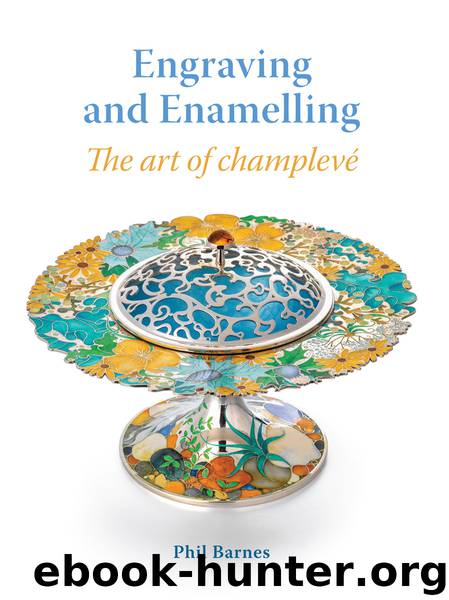Engraving and Enamelling by Phil Barnes

Author:Phil Barnes
Language: eng
Format: epub
ISBN: 9781785005466
Publisher: Crowood
CHAPTER 7
Tools, Equipment and Enamels
THE ENAMELLER’S BENCH
A bench suitable for enamelling should be of a comfortable height with plenty of space to spread out tools and materials; an adjustable seat and good lighting must be the first considerations of any working bench. For enamelling it doesn’t need to have a cut-out, just a straight-edged table is fine, but establishing a good, comfortable working height is important.
The enameller’s bench.
You will need the following tools and equipment for enamelling:
• Apart from quills, add in a paintbrush, some plasticine for holding the work, some absorbent cotton cloths, a palette knife and tweezers
• China watercolour palette dishes for holding the enamels work well: china has more weight than plastic, and doesn’t move as you are trying to work
• You will also need carborundum stones, Diagrit strips, and wet-and-dry emery paper for stoning and finishing
• Always keep a small water bottle on the bench filled with purified water. Every time you finish work with an enamel, maybe to get up to fire or when work is finished, it is good practice to make sure the enamel is always covered with clean water; also, keep that water refreshed as work continues, to cut out any film or scum developing on the enamel. When returning to enamel, pour off the old water: keep an old jar on the bench for this, and begin a cycle of replacing the water constantly through the working day. If the enamel is left to dry out, or is left sitting in old water, this will affect the quality of the finish – and a simple task such as replacing the water is a good habit to get into
• You will need at least one pestle and mortar for grinding the enamels, and it is wise to have mortars in two sizes to allow for different volumes of enamel to be ground
• Good airtight storage for the enamels in a dry place will be needed: while lump enamels may not be so much of a problem, pre-ground powdered enamels will be, and must be kept dry – any dampness or moisture is to be avoided at all costs
• A label machine in the workshop is a good thing to have for marking enamel jars and pots of enamel, as it is not always obvious what a colour is – a strong golden yellow, for example, may look like a clear flux in some cases, so a clear marking system will help avoid any confusion
• Easy access to good running water is essential for an enameller, and at the sink, make sure you have both brass and black bristle brushes on hand, and a container with water and detergent
• Some strong rubber gloves, protective glasses, long tweezers, and plastic trays and boxes for use with acids
• Up at the kiln, a pair of tongs or a firing fork, whichever is preferred, a pair of large size tweezers, a protective glove against the heat, and if it is a concern, some protective green-tinted, anti-glare
Download
This site does not store any files on its server. We only index and link to content provided by other sites. Please contact the content providers to delete copyright contents if any and email us, we'll remove relevant links or contents immediately.
On Writing A Memoir of the Craft by Stephen King(4864)
The Doodle Revolution by Sunni Brown(4690)
A Simplified Life by Emily Ley(4099)
Mummy Knew by Lisa James(3637)
Marijuana Grower's Handbook by Ed Rosenthal(3623)
Better Homes and Gardens New Cookbook by Better Homes & Gardens(3529)
Figure Drawing for Artists by Steve Huston(3384)
Paper Parties by Erin Hung(3373)
Draw Your Day by Samantha Dion Baker(3292)
The Genius of Japanese Carpentry by Azby Brown(3228)
Japanese Design by Patricia J. Graham(3112)
The Code Book by Simon Singh(3077)
Dangerous Girls by Haas Abigail(2981)
Lions and Lace by Meagan Mckinney(2926)
The Curated Closet by Anuschka Rees(2915)
How to Make Your Own Soap by Sally Hornsey(2833)
The Checklist Manifesto by Atul Gawande(2781)
The Wardrobe Wakeup by Lois Joy Johnson(2733)
Zero to Make by David Lang(2727)
